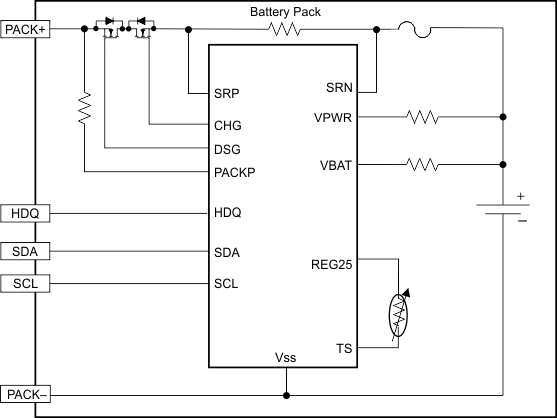SLUSBF2C July 2013 – August 2015
PRODUCTION DATA.
- 1 Features
- 2 Applications
- 3 Description
- 4 Revision History
- 5 Device Comparison Table
- 6 Pin Configuration and Functions
-
7 Specifications
- 7.1 Absolute Maximum Ratings
- 7.2 ESD Ratings
- 7.3 Recommended Operating Conditions
- 7.4 Thermal Information
- 7.5 Power-On Reset
- 7.6 2.5-V LDO Regulator
- 7.7 Charger Attachment and Removal Detection
- 7.8 Voltage Doubler
- 7.9 Overvoltage Protection (OVP)
- 7.10 Undervoltage Protection (UVP)
- 7.11 Overcurrent in Discharge (OCD)
- 7.12 Overcurrent in Charge (OCC)
- 7.13 Short-Circuit in Discharge (SCD)
- 7.14 Low-Voltage Charging
- 7.15 Internal Temperature Sensor Characteristics
- 7.16 Internal Clock Oscillators
- 7.17 Integrating ADC (Coulomb Counter) Characteristics
- 7.18 ADC (Temperature and Cell Voltage) Characteristics
- 7.19 Data Flash Memory Characteristics
- 7.20 I2C-Compatible Interface Timing Characteristics
- 7.21 HDQ Communication Timing Characteristics
- 7.22 Typical Characteristics
-
8 Detailed Description
- 8.1 Overview
- 8.2 Functional Block Diagram
- 8.3 Feature Description
- 8.4
Device Functional Modes
- 8.4.1 NORMAL Mode
- 8.4.2 SLEEP Mode
- 8.4.3 FULLSLEEP Mode
- 8.4.4
Battery Protector Description
- 8.4.4.1 High-Side N-Channel FET Charge and Discharge FET Drive
- 8.4.4.2
Operating Modes
- 8.4.4.2.1 VIRTUAL SHUTDOWN Mode
- 8.4.4.2.2 UNDERVOLTAGE FAULT Mode
- 8.4.4.2.3 NORMAL Mode
- 8.4.4.2.4 SHUTDOWN WAIT Mode
- 8.4.4.2.5 OVERCURRENT IN DISCHARGE (OCD) and SHORT-CIRCUIT IN DISCHARGE (SCD) FAULT Mode
- 8.4.4.2.6 OVERCURRENT IN CHARGE (OCC) FAULT Mode
- 8.4.4.2.7 OVERVOLTAGE PROTECTION (OVP) FAULT Mode
- 8.4.4.3 Firmware Control of Protector
- 8.4.5 OVERTEMPERATURE FAULT Mode
-
9 Application and Implementation
- 9.1 Application Information
- 9.2
Typical Applications
- 9.2.1
Pack-Side, Single-Cell Li-Ion Fuel Gauge and Protector
- 9.2.1.1 Design Requirements
- 9.2.1.2
Detailed Design Procedure
- 9.2.1.2.1 BAT Voltage Sense Input
- 9.2.1.2.2 SRP and SRN Current Sense Inputs
- 9.2.1.2.3 Sense Resistor Selection
- 9.2.1.2.4 TS Temperature Sense Input
- 9.2.1.2.5 Thermistor Selection
- 9.2.1.2.6 VPWR Power Supply Input Filtering
- 9.2.1.2.7 REG25 LDO Output Filtering
- 9.2.1.2.8 Communication Interface Lines
- 9.2.1.2.9 PACKP Voltage Sense Input
- 9.2.1.2.10 CHG and DSG Charge Pump Voltage Outputs
- 9.2.1.2.11 N-Channel FET Selection
- 9.2.1.2.12 Additional ESD Protection Components
- 9.2.1.3 Application Curves
- 9.2.1
Pack-Side, Single-Cell Li-Ion Fuel Gauge and Protector
- 10Power Supply Recommendations
- 11Layout
- 12Device and Documentation Support
- 13Mechanical, Packaging, and Orderable Information
Package Options
Mechanical Data (Package|Pins)
- YZF|15
Thermal pad, mechanical data (Package|Pins)
Orderable Information
1 Features
- Battery Fuel Gauge and Protector for 1-Series Li-Ion Applications
- Microcontroller Peripheral Provides:
- Accurate Battery Fuel Gauging Supports up to 14,500 mAh
- External and Internal Temperature Sensors for Battery Temperature Reporting
- Precision 16-Bit High-Side Coulomb Counter with High-Side Low-Value Sense Resistor
(5 mΩ to 20 mΩ) - Lifetime and Current Data Logging
- 64 Bytes of Non-Volatile Scratch Pad Flash
- SHA-1/HMAC Authentication
- Battery Fuel Gauging Based on Patented Impedance
Track™ Technology
- Models Battery Discharge Curve for Accurate Time-To-Empty Predictions
- Automatically Adjusts for Aging, Self-Discharge, and Temperature- and Rate-Induced Effects on Battery
- Advanced Fuel Gauging Features
- Internal Short Detection
- Tab Disconnection Detection
- Safety and Protection:
- Over- and Undervoltage Protection with Low-Power Mode
- Overcharging and Discharging Current Protection
- Overtemperature Protection
- Short-Circuit Protection
- Low-Voltage Notification
- Voltage Doubler to Support High-Side
N-Channel FET Protection
- HDQ and I2C Interface Formats for Communication with Host System
- Small 15-Ball NanoFree™ (BGA) Packaging
2 Applications
- Smartphones
- PDAs
- Digital Still and Video Cameras
- Handheld Terminals
- MP3 or Multimedia Players
3 Description
The Texas Instruments bq27741-G1 Li-Ion battery fuel gauge is a microcontroller peripheral that provides fuel gauging for single-cell Li-Ion battery packs. The device requires little system microcontroller firmware development for accurate battery fuel gauging. The fuel gauge resides within the battery pack or on the system’s main board with an embedded battery (non-removable). The fuel gauge provides hardware-based over- and undervoltage, overcurrent in charge or discharge, and short-circuit protections.
The fuel gauge uses the patented Impedance Track™ algorithm for fuel gauging, and provides information such as remaining battery capacity (mAh), state-of-charge (%), run-time to empty (minimum), battery voltage (mV), and temperature (°C), as well as recording vital parameters throughout the lifetime of the battery.
The device comes in a 15-ball BGA package (2.776 mm × 1.96 mm) that is ideal for space-constrained applications.
Device Information(1)
| PART NUMBER | PACKAGE | BODY SIZE (NOM) |
|---|---|---|
| bq27741-G1 | YZF (15) | 2.78 mm × 1.96 mm |
- For all available packages, see the orderable addendum at the end of the data sheet.
Simplified Schematic

4 Revision History
Changes from B Revision (April 2015) to C Revision
- Changed Pin Configuration and FunctionsGo
- Changed Absolute Maximum RatingsGo
- Changed Recommended Operating ConditionsGo
- Deleted UNDERTEMPERATURE FAULT ModeGo
- Added Community ResourcesGo